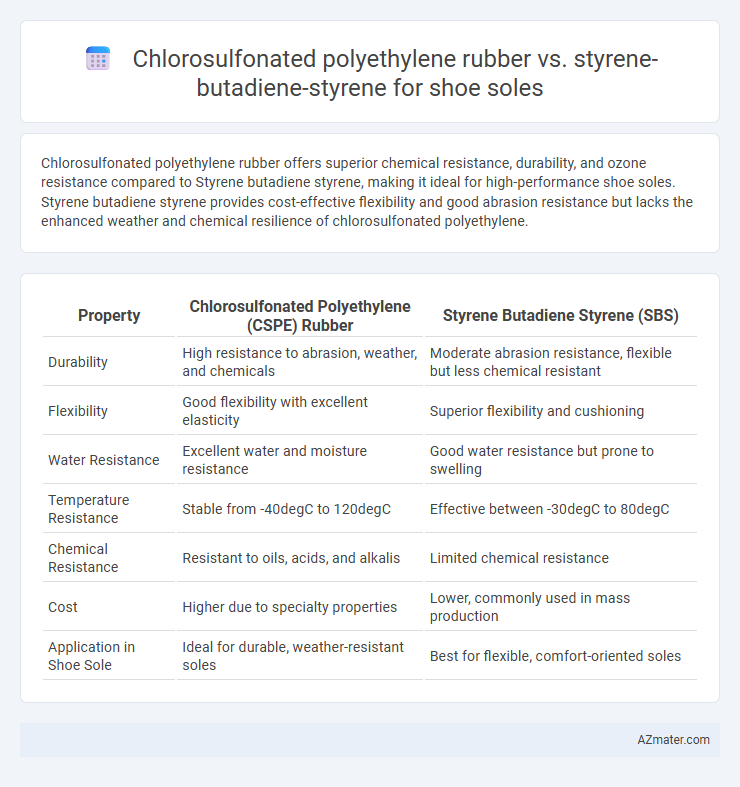Chlorosulfonated polyethylene rubber offers superior chemical resistance, durability, and ozone resistance compared to Styrene butadiene styrene, making it ideal for high-performance shoe soles. Styrene butadiene styrene provides cost-effective flexibility and good abrasion resistance but lacks the enhanced weather and chemical resilience of chlorosulfonated polyethylene.
Table of Comparison
| Property | Chlorosulfonated Polyethylene (CSPE) Rubber | Styrene Butadiene Styrene (SBS) |
|---|---|---|
| Durability | High resistance to abrasion, weather, and chemicals | Moderate abrasion resistance, flexible but less chemical resistant |
| Flexibility | Good flexibility with excellent elasticity | Superior flexibility and cushioning |
| Water Resistance | Excellent water and moisture resistance | Good water resistance but prone to swelling |
| Temperature Resistance | Stable from -40degC to 120degC | Effective between -30degC to 80degC |
| Chemical Resistance | Resistant to oils, acids, and alkalis | Limited chemical resistance |
| Cost | Higher due to specialty properties | Lower, commonly used in mass production |
| Application in Shoe Sole | Ideal for durable, weather-resistant soles | Best for flexible, comfort-oriented soles |
Introduction to Chlorosulfonated Polyethylene Rubber and Styrene Butadiene Styrene
Chlorosulfonated polyethylene (CSM) rubber is a synthetic elastomer known for its exceptional resistance to ozone, weather, and chemicals, making it highly durable for shoe sole applications exposed to harsh conditions. Styrene butadiene styrene (SBS) is a thermoplastic elastomer combining the elasticity of rubber with the processability of plastics, offering excellent flexibility, abrasion resistance, and cushioning ideal for comfortable, lightweight shoe soles. Both materials serve distinct roles in footwear manufacturing, with CSM providing enhanced durability and SBS offering superior comfort and resilience.
Chemical Structure and Composition Comparison
Chlorosulfonated polyethylene (CSPE) rubber features a polyethylene backbone with chlorosulfonic acid groups, providing excellent chemical resistance and durability for shoe soles. Styrene butadiene styrene (SBS) is a block copolymer consisting of polystyrene end blocks and a flexible polybutadiene midblock, offering superior elasticity and abrasion resistance. The chlorosulfonated groups in CSPE enhance weather and ozone resistance, while the styrene blocks in SBS deliver toughness and flexibility essential for cushioning and impact absorption in footwear applications.
Mechanical Properties: Durability and Flexibility
Chlorosulfonated polyethylene (CSM) rubber exhibits superior durability and excellent resistance to abrasion, ozone, and chemical exposure, making it highly suitable for long-lasting shoe soles. Styrene butadiene styrene (SBS) offers enhanced flexibility and good cushioning properties but may exhibit lower resistance to wear and environmental degradation compared to CSM. For applications requiring robust mechanical properties such as prolonged durability and flexibility, CSM rubber is generally preferred over SBS in shoe sole manufacturing.
Abrasion and Wear Resistance in Shoe Soles
Chlorosulfonated polyethylene rubber (CSM) outperforms Styrene butadiene styrene (SBS) in abrasion and wear resistance, making it highly suitable for durable shoe soles subjected to harsh conditions. CSM provides enhanced resistance to chemicals, ozone, and UV radiation, which contributes to its superior longevity in footwear applications. SBS offers flexibility but generally exhibits lower abrasion resistance, leading to faster degradation in high-wear shoe sole environments.
Water and Chemical Resistance Capabilities
Chlorosulfonated polyethylene (CSPE) rubber exhibits superior water and chemical resistance compared to Styrene butadiene styrene (SBS), making it ideal for shoe soles exposed to harsh environments. CSPE's chlorine and sulfonyl groups enhance its impermeability to acids, alkalis, and hydrocarbons, while SBS tends to degrade upon prolonged exposure to oils and solvents. This resistance ensures longer durability and maintains sole integrity in wet and chemically aggressive conditions.
Comfort and Cushioning Performance
Chlorosulfonated polyethylene (CSPE) rubber offers superior chemical resistance and durability for shoe soles, enhancing long-term comfort by maintaining structural integrity under stress. Styrene butadiene styrene (SBS) provides excellent cushioning performance due to its flexibility and elasticity, resulting in improved shock absorption and foot comfort during prolonged wear. While CSPE excels in durability and resistance to environmental factors, SBS is favored for its responsive cushioning and lightweight feel in footwear applications.
Cost Efficiency and Manufacturing Considerations
Chlorosulfonated polyethylene (CSM) rubber offers superior chemical resistance and weather durability, making it cost-efficient for shoe soles subjected to harsh environments, despite higher raw material costs and more complex curing processes. Styrene butadiene styrene (SBS) provides a lower-cost alternative with easier processing and faster manufacturing cycles, but it generally lacks the enhanced durability and chemical resistance of CSM, potentially increasing long-term replacement expenses. Manufacturers must balance upfront material costs and production efficiencies of SBS against the robust performance and extended lifecycle benefits of CSM for overall cost-effectiveness in shoe sole applications.
Environmental Impact and Sustainability
Chlorosulfonated polyethylene (CSM) rubber offers enhanced chemical resistance and durability, which contributes to longer shoe sole lifespan and reduced material waste compared to Styrene Butadiene Styrene (SBS). SBS soles, while providing good flexibility and cushioning, are derived from non-renewable petroleum sources and have a slower biodegradation rate, posing higher environmental concerns. CSM's resistance to ozone and weathering reduces the frequency of sole replacement, supporting sustainability through durability, although both materials require proper end-of-life recycling to minimize environmental impact.
Typical Applications in Footwear Industry
Chlorosulfonated polyethylene (CSM) rubber is widely used in shoe soles for its exceptional resistance to chemicals, weathering, and ozone, making it ideal for durable, outdoor, and work footwear applications. Styrene butadiene styrene (SBS) offers excellent elasticity and cushioning properties, commonly found in athletic and casual shoe soles requiring flexibility and impact absorption. Both materials enhance performance and longevity, with CSM chosen for rugged environments and SBS preferred for comfort-focused designs in the footwear industry.
Conclusion: Which Material Suits Shoe Soles Best?
Chlorosulfonated polyethylene (CSPE) rubber excels in chemical and weather resistance, offering superior durability and flexibility for shoe soles exposed to harsh conditions. Styrene butadiene styrene (SBS) provides enhanced elasticity and impact absorption, making it ideal for athletic and casual footwear requiring comfort and shock resistance. For shoe soles demanding long-term resilience against environmental factors, CSPE is best suited, while SBS is preferable for applications prioritizing cushioning and flexibility.

Infographic: Chlorosulfonated polyethylene rubber vs Styrene butadiene styrene for Shoe sole
 azmater.com
azmater.com